A)Broad demographic (人口的)shifts in marital status, educational attainment and employment have transformed the way young adults in the U. S. are living, and a new Pew Research Center analysis highlights the implications of these changes for the most basic element of their lives -- where they call home. In 2014, for the first time in more than 130 years, adults ages 18 to 34 were slightly more likely to be living in their parents' home than they were to be living with a spouse or partner in their own household.
B)This turn of events is fueled primarily by the dramatic drop in the share of young Americans who are choosing to settle down romantically before age 35. Dating back to 1880, the most common living arrangement among young adults has been living with a romantic partner, whether a spouse or a significant other. This type of arrangement peaked around I960, when 62% of the nation's 18- to 34-year-olds were living with a spouse or partner in their own household, and only one-in-five were living with their parents.
C)By 2014, 31.6% of young adults were living with a spouse or partner in their own household, below the share living in the home of their parent(s) (32.1%). Some 14% of young adults lived alone, were a single parent or lived with one or more roommates. The remaining 22% lived in the home of another family member (such as a grandparent, in-law or sibling), a non-relative, or in group quarters like college dormitories.
D)It's worth noting that the overall share of young adults living with their parents was not at a record high in 2014. This arrangement peaked around 1940, when about 35% of the nation's 18- to 34-year- olds lived with mom and/or dad (compared with 32% in 2014). What has changed, instead, is the relative share adopting different ways of living in early adulthood, with the decline of romantic coupling pushing living at home to the top of a much less uniform list of living arrangements.
E)Among young adults, living arrangements differ significantly by gender. For men aged 18 to 34, living at home with mom and/or dad has been the dominant living arrangement since 2009. In 2014, 28% of young men were living with a spouse or partner in their own home, while 35% were living in the home of their parent (s). Young women, however, are still more likely to be living with a spouse or romantic partner (35%) than they are to be living with their parent(s) (29%).
F)In 2014, more young women (16%) than young men (13%) were heading up a household without a spouse or partner. This is mainly because women are more likely than men to be single parents living with their children. For their part, young men (25%) are more likely than young women (19%) to be living in the home of another family member, a non-relative or in some type of group quarters.
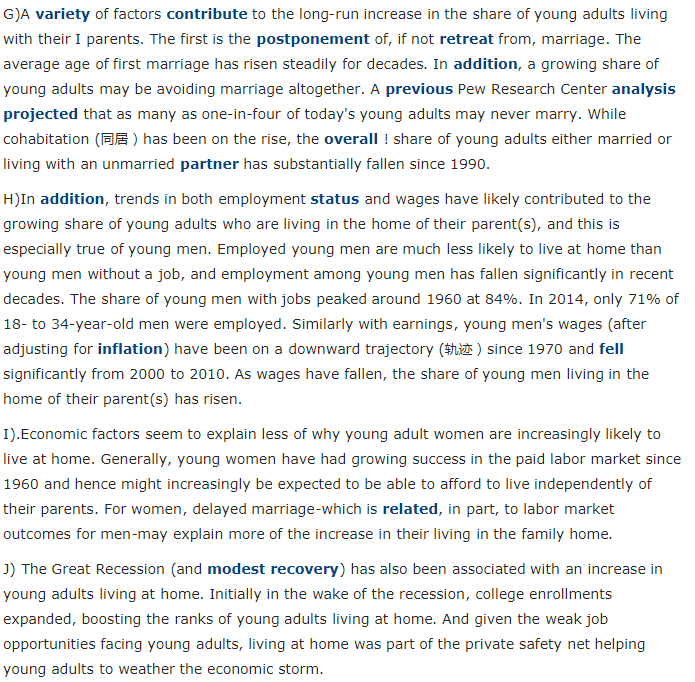
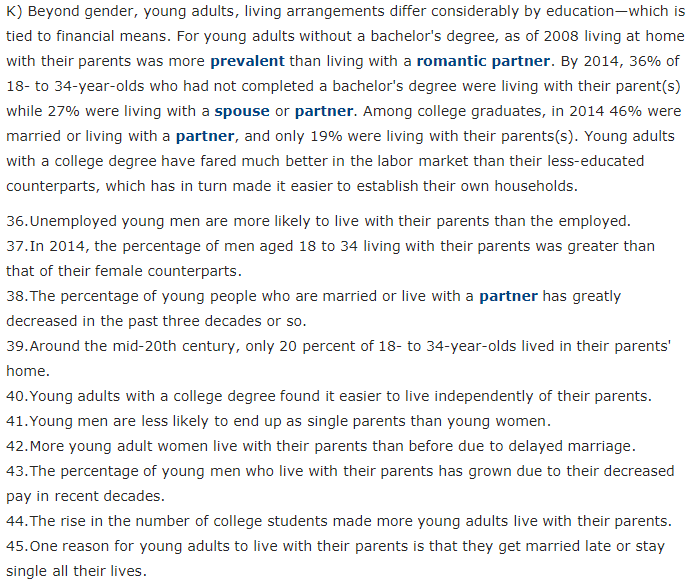
正确答案及解析
正确答案
36-45:HEGBK FIHGJ
解析
36.失业的年轻人比有工作的人更可能和父母住在一起。
37.2014年,与父母同住的18至34岁男性比例高于女性。
38.在过去三十年左右的时间里,已婚或与伴侣同居的年轻人的比例大大下降。
39.大约在20世纪中叶,只有20%的18到34岁的人住在父母家里。
40.拥有大学学位的年轻人发现独立于父母生活更容易。
41.与年轻女性相比,年轻男性不太可能成为单身父母。
42.由于晚婚,与父母同住的年轻女性比以前多了。
43.由于近几十年来工资的下降,与父母同住的年轻男子比例有所上升。
44.大学生人数的增加使更多的年轻人与父母住在一起。
45.年轻人和父母住在一起的一个原因是他们结婚晚了或者一辈子都是单身。
你可能感兴趣的试题
Textbooks represent an 11 billion dollar industry, up from $8 billion in 2014. Textbook publisher Pearson is the largest publisher -- of any kind -- in the world.
It costs about $1 million to create a new textbook. A freshman textbook will have dozens of contributors, from subject-matter experts through graphic and layout artists to expert reviewers and classroom testers. Textbook publishers connect professors, instructors and students in ways that alternatives, such as open e-textbooks and open educational resources, simply do not. This connection happens not only by means of collaborative development, review and testing, but also at conferences where faculty regularly decide on their textbooks and curricula for the coming year.
It is true that textbook publishers have recently reported losses, largely due to students renting or buying used print textbooks. But this can be chalked up to the excessively high cost of their books -- which has increased over 1,000 percent since 1977. A restructuring of the textbook industry may well be in order. But this does not mean the end of the textbook itself.
While they may not be as dynamic as an iPad, textbooks are not passive or lifeless. For example, over the centuries, they have simulated (模拟) dialogues in a number of ways. From 1800 to the present day, textbooks have done this by posing questions for students to answer inductively (归纳性地). That means students are asked to use their individual experience to come up with answers to general questions. Today's psychology texts, for example, ask: "How much of your personality do you think you inherited?" while ones in physics say: "How can you predict where the ball you tossed will land?"
Experts observe that "textbooks come in layers, something like an onion." For an active learner, engaging with a textbook can be an interactive experience. Readers proceed at their own pace. They "customize" their books by engaging with different layers and linkages. Highlighting, Post-It notes, dog-ears and other techniques allow for further customization that students value in print books over digital forms of books.
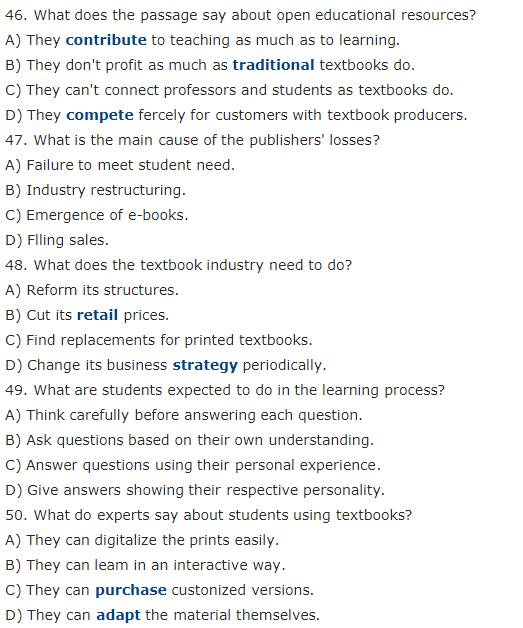
- 查看答案
When we think of animals and plants, we have a pretty good way of dividing them into two distinct groups: one converts sunlight into energy and the other has to eat food to make its energy. Well, those dividing lines come crashing down with the discovery of a sea slug (海蛞蝓) that's truly half animal and half plant. It's pretty incredible how it has managed to hijack the genes of the algae (藻类) on which it feeds.
The slugs can manufacture chlorophyll, the green pigment (色素) in plants that captures energy from sunlight, and hold these genes within their body. The term kleptoplasty is used to describe the practice of using hijacked genes to create nutrients from sunlight. And so far, this green sea slug is the only known animal that can be truly considered solar-powered, although some animals do exhibit some plant-like behaviors. Many scientists have studied the green sea slugs to confirm that they are actually able to create energy from sunlight.
In fact, the slugs use the genetic material so well that they pass it on to their future generations. Their babies retain the ability to produce their own chlorophyll, though they can't generate energy from sunlight until they've eaten enough algae to steal the necessary genes, which they can't yet produce on their own.
"There's no way on earth that genes from an alga should work inside an animal cell," says Sidney Pierce from the University of South Florida. "And yet here, they do. They allow the animal to rely on sunshine for its nutrition. So if something happens to their food source, they have a way of not starving to death until they find more algae to eat."
The sea slugs are so good at gathering energy from the sun that they can live up to nine months without having to eat any food. They get all their nutritional needs met by the genes that they've hijacked from the algae.
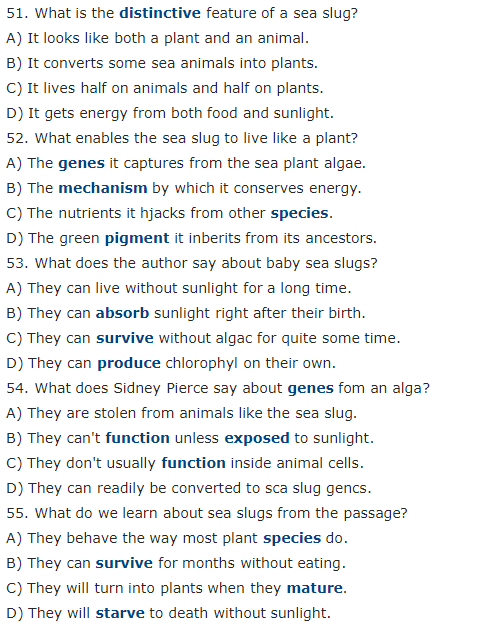
- 查看答案
For this part, you are allowed 30 minutes to write a letter to a foreign friend who wants to teach English in China. Please recommend a city to him. You should write at least 120 words but no more than 180 words.
- 查看答案
A) We've always been a hands-on, do it-yourself kind of nation. Ben Franklin, one of America's founding fathers, didn't just invent the lightning rod. His creations include glasses, innovative stoves and more.
B) Franklin, who was largely self-taught, may have been a genius, but he wasn't really an exception when it comes to American making and creativity.
C) The personal computing revolution and philosophy of disruptive innovation of Silicon Valley grew, in part, out of the creations of the Homebrew Computer Club, which was founded in a garage in Menlo Park, California, in the mid-1970s. Members-including guys named Jobs and Wozniak-started making and inventing things they couldn't buy.
D) So it's no surprise that the Maker Movement today is thriving in communities and some schools across America. Making is available to ordinary people who aren't tied to big companies, big defense labs or research universities. The maker philosophy echoes old ideas advocated by John Dewey, Montessori, and even ancient Greek philosophers, as we pointed out recently.
E) These maker spaces are often outside of classrooms, and are serving an important educational function. The Maker Movement is rediscovering learning by doing, which is Dewey's phrase from 100 years ago. We are rediscovering Dewey and Montessori and a lot of the practices that they pioneered that have been forgotten or at least put aside. A maker space is a place which can be in a school, but it doesn't look like a classroom. It can be in a library. It can be out in the community. It has tools and materials. It's a place where you get to make things based on your interest and on what you, re learning to do.
F) Ideas about learning by doing have struggled to become mainstream educationally, despite being old concepts from Dewey and Montessori, Plato and Aristotle, and in the American context, Ralph Emerson, on the value of experience and self-reliance. It's not necessarily an efficient way to learn. We learn, in a sense, by trial and error. Learning from experience is something that takes time and patience. It's very individualized. If your goal is to have standardized approaches to learning, where everybody learns the same thing at the same time in the same way, then learning by doing doesn't really fit that mold anymore. It's not the world of textbooks. It's not the world of testing.
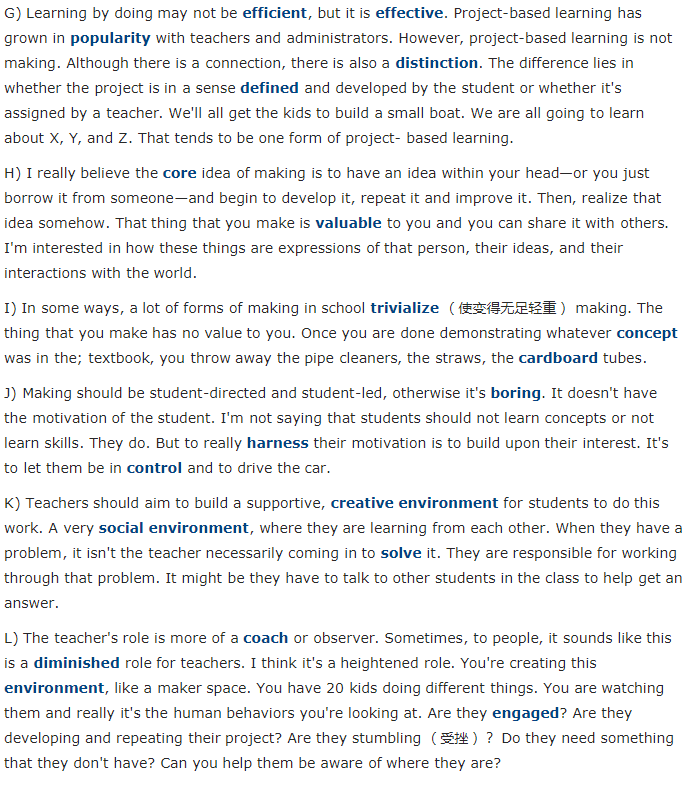
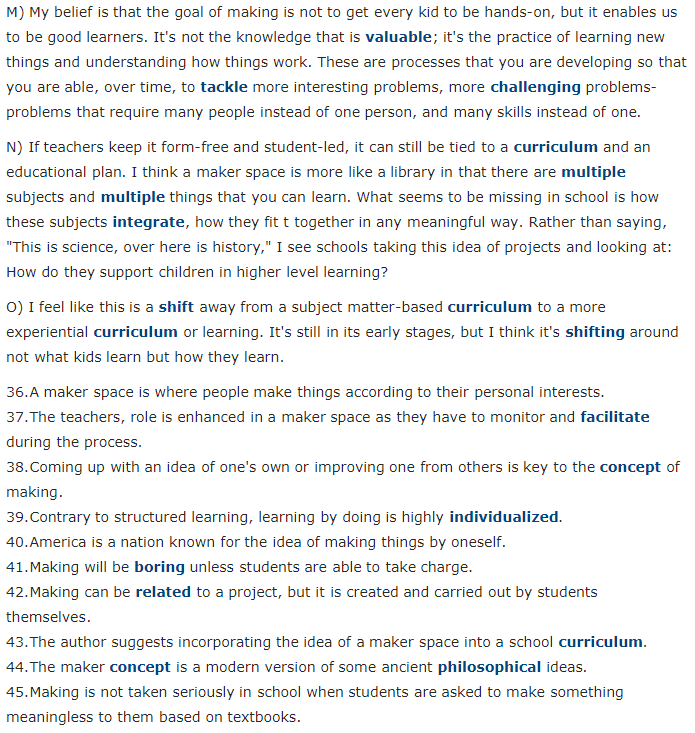
- 查看答案
Professor Ashok Goel of Georgia Tech developed an artificially intelligent teaching assistant to help handle the enormous number of student questions in the online class, Knowledge-Based Artificial Intelligence. This online course is a core requirement of Georgia Tech's online Master of Science in Computer Science program. Professor Goel already had eight teaching assistants, but that wasn't enough to deal with the overwhelming number of daily questions from students.
Many students drop out of online courses because of the lack of teaching support. When students feel isolated or confused and reach out with questions that go unanswered, their motivation to continue begins to fade. Professor Goel decided to do something to remedy this situation and his solution was to create a virtual assistant named Jill Watson, which is based on the IBM Watson platform.
Goel and his team developed several versions of Jill Watson before releasing her to the online forums. At first, the virtual assistant wasn't too great. But Goel and his team sourced the online discussion forum to find all the 40,000 questions that had ever been asked since the class was launched. Then they began to feed Jill with the questions and answers. After some adjustments and sufficient time, Jill was able to answer the students' questions correctly 97% of the time. The virtual assistant became so advanced and realistic that the students didn't know she was a computer. The students, who were studying artificial intelligence, were interacting with the virtual assistant and couldn't tell it apart from a real human being. Goel didn't inform them about Jill's true identity until April 26. The students were actually very positive about the experience.
The goal of Professor Goel's virtual assistant next year is to take over answering 40% of all the questions posed by students on the online forum. The name Jill Watson will, of course, change to something else next semester. Professor Goel has a much rosier outlook on the future of artificial intelligence than, say, Elon Musk, Stephen Hawking, Bill Gates or Steve Wozniak.
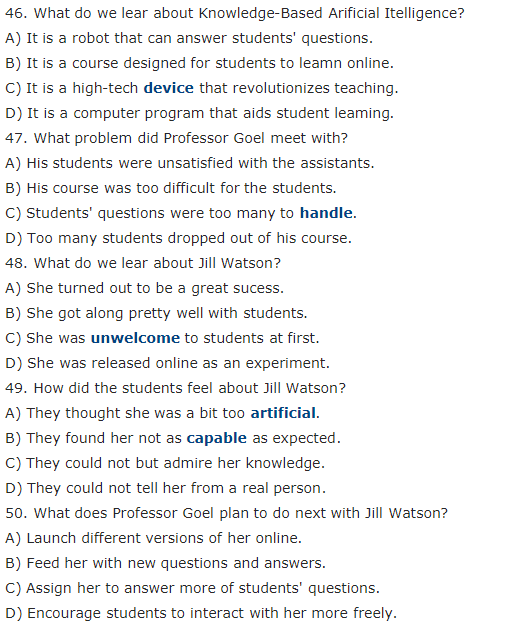
- 查看答案